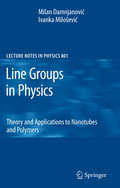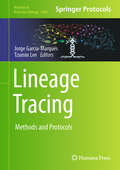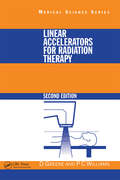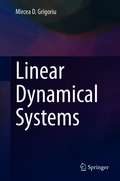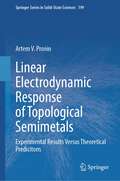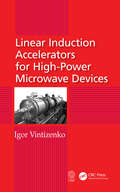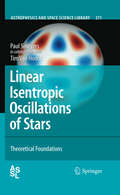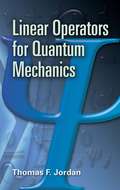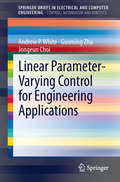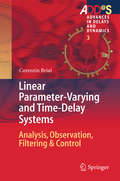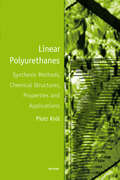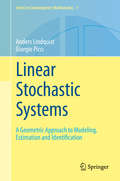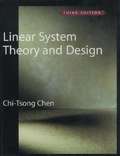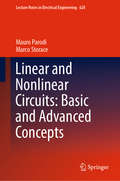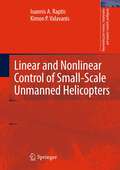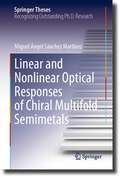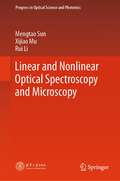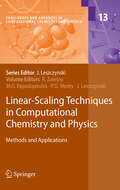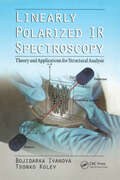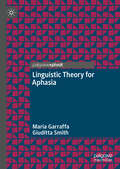- Table View
- List View
Line Groups in Physics
by Milan Damnjanovic Ivanka MilosevicThis volume gives a detailed and up-to-date overview of the line groups, the groups that describe the symmetry of quasi-one dimensional crystals. Nanotubes, nanowires, nanosprings, nanorods, and polymers are examples remarkable enough to have kept nanoscience as a leading field within material science and solid state physics for more than fifteen years now. The authors present the mathematical foundations, including classifications of the line groups, quasi one-dimensional crystals and quantum numbers, together with important applications. Extensive illustrations related to the physics of nanotubes make the book essential reading in this field above all. The book clearly demonstrates how symmetry is a most profound property of nature and contains valuable results that are published here for the first time.
Line Up!: Animals in Remarkable Rows
by Susan StockdaleLine up for this fascinating exploration of animal behavior from an award-winning author-illustrator!Much like humans, many animals line up for a variety of reasons. Rather than forming lines for the school bus or recess, the animals featured in Susan Stockdale&’s book form lines forsafety: baby Mallard ducklings follow their mother to the water for their first swimwarmth: turtles climb into a stacked line for a better share of the sun&’s raysnavigation: Arctic wolves follow the prints in the snow left by the pack leaderfood: ants line up to follow the scent of their leader to food and safetytravel: pink flamingos form a line to reduce wind resistance and fly more efficiently Featuring birds, crustaceans, fish, insects, mammals, and reptiles from around the world, Line Up is a cozy and comforting book that reminds us of our similarities while illuminating some specific, distinctive behaviors.
Lineage Tracing: Methods and Protocols (Methods in Molecular Biology #2886)
by Jorge García-Marqués Tzumin LeeThis volume covers the state-of-art lineage tracing methods, to record these recent multi-front rapid progresses and promote development of further powerful tools. Chapters explores a broad spectrum of techniques that have been developed and refined over the years, offering a detailed exposition of their principles, applications, and limitations. Additional chapters cover classic methods, such as genetic lineage tracing, clonal analysis, single-cell RNA sequencing, and live-cell imaging. Written in the highly successful Methods in Molecular Biology series format, chapters include introductions to their respective topics, lists of the necessary materials and reagents, step-by-step, readily reproducible laboratory protocols, and key tips on troubleshooting and avoiding known pitfalls. Authoritative and cutting-edge, Lineage Tracing: Methods and Protocols aims to serve as a valuable resource, fostering new discoveries and advancements in the exciting field of cell lineage tracing.
Linear Accelerators for Radiation Therapy (ISSN)
by David Greene P.C WilliamsLinear Accelerators for Radiation Therapy, Second Edition focuses on the fundamentals of accelerator systems, explaining the underlying physics and the different features of these systems. This edition includes expanded sections on the treatment head, on x-ray production via multileaf and dynamic collimation for the production of wedged and other intensity modulated beams, on electron scattering systems, and on dosimetry. With high-quality illustrations and practical examples throughout, it contains a detailed description of electron beam optics and linear accelerator components. The final chapter explains how to use other equipment, such as scanners and simulators, in conjunction with linear accelerators for optimum treatment of cancers.
Linear CMOS RF Power Amplifiers for Wireless Applications
by Paulo Augusto Dal Fabbro Maher KayalThe RF power amplifier is a key component in a wireless transceiver and is considered by many as the design bottleneck in the transmitting chain. Linear CMOS RF Power Amplifiers for Wireless Applications addresses two fundamental aspects in RF power amplifier design for integration in CMOS technologies at 2.4, 3.7 and 5.2 GHz: efficiency enhancement and frequency agility. The well-known linearity-efficiency trade-off is circumvented by employing an efficiency-enhancement technique called the dynamic supply RF power amplifier. The design of this system is described with great detail and compared with other efficiency enhancement techniques. The frequency agility is achieved with a novel impedance matching network based on coupled inductors. The design of a dual-band RF power amplifier is shown, with a careful analysis of the tunable matching network and its interaction with the rest of the circuit. The considerations and conclusions drawn throughout this book are based on simulation as well as measurement results from the integrated circuit prototypes carefully built and respecting best practices in RF design.
Linear Canonical Transforms
by John J. Healy M. Alper Kutay Haldun M. Ozaktas John T. SheridanThis book provides a clear and accessible introduction to the essential mathematical foundations of linear canonical transforms from a signals and systems perspective. Substantial attention is devoted to how these transforms relate to optical systems and wave propagation. There is extensive coverage of sampling theory and fast algorithms for numerically approximating the family of transforms. Chapters on topics ranging from digital holography to speckle metrology provide a window on the wide range of applications. This volume will serve as a reference for researchers in the fields of image and signal processing, wave propagation, optical information processing and holography, optical system design and modeling, and quantum optics. It will be of use to graduate students in physics and engineering, as well as for scientists in other areas seeking to learn more about this important yet relatively unfamiliar class of integral transformations.
Linear Dynamical Systems
by Mircea D. GrigoriuThis textbook provides a concise, clear, and rigorous presentation of the dynamics of linear systems that delivers the necessary tools for the analysis and design of mechanical/ structural systems, regardless of their complexity. The book is written for senior undergraduate and first year graduate students as well as engineers working on the design of mechanical/structural systems subjected to dynamic actions, such as wind/earthquake engineers and mechanical engineers working on wind turbines. Professor Grigoriu's lucid presentation maximizes student understanding of the formulation and the solution of linear systems subjected to dynamic actions, and provides a clear distinction between problems of practical interest and their special cases. Based on the author's lecture notes from courses taught at Cornell University, the material is class-tested over many years and ideal as a core text for a range of classes in mechanical, civil, and geotechnical engineering, as well as for self-directed learning by practitioners in the field.
Linear Electrodynamic Response of Topological Semimetals: Experimental Results Versus Theoretical Predicitons (Springer Series in Solid-State Sciences #199)
by Artem V. ProninThis book provides a model description for the electromagnetic response of topological nodal semimetals and summarizes recent experimental findings in these systems. Specifically, it discusses various types of topological semimetals – Dirac, Weyl, nodal-line, triple-point, and multifold semimetals – and provides description for the characteristic features of the linear electrodynamic response for all these types of materials.Topological semimetals possess peculiar bulk electronic band structure, which leads to unusual electrodynamic response. For example, the low-energy inter-band optical conductivity of nodal semimetals is supposed to demonstrate power-law frequency dependence and the intra- and inter-band contributions to the conductivity are often mixed. Further, the magneto-optical response is also unusual, because of the non-equidistant spacing between the Landau levels. Finally, in semimetals with chiral electronic bands, e.g. in Weyl semimetals, the simultaneous application of parallel magnetic and electric fields leads to the chiral anomaly, i.e. to a misbalance between the electrons with diffident chiralities. This misbalance affects the electrodynamics properties of the material and can be detected optically. All these points are addressed here in detail.The book is written for a wide audience of physicists, working in the field of topological condensed matter physics. It gives a pedagogical introduction enabling graduate students and non-experts to familiarize themselves with the subject.
Linear Induction Accelerators for High-Power Microwave Devices
by Igor VintizenkoLinear induction accelerators are successfully used as power supplies for numerous devices of relativistic high-frequency electronics. This book addresses ways to solve physical and engineering problems arising in the calculation, design, modeling and operation of linear induction accelerators intended for supplying relativistic microwave devices. It reviews and analyzes both classic and recent studies on the topic of linear induction accelerators (LIA) for generating and amplifying microwave radiation by relativistic devices.
Linear Isentropic Oscillations of Stars
by Paul Smeyers Tim Van HoolstThe study of stellar oscillations is the preeminent way to investigate the stability of stars and to interpret their variability. The theory of the linear, isentropic oscillations of isolated gaseous stars, and thus of compressible spherically symmetric equilibrium configurations, has largely been developed from the viewpoint of the hypothesis of the physical radial pulsations of stars. Written for doctoral students and researchers, this monograph aims to provide a systematic and consistent survey of the fundamentals of the theory of free, linear, isentropic oscillations in spherically symmetric, gaseous equilibrium stars. The first part of the book presents basic concepts and equations, the distinction between spheroidal and toroidal normal modes, the solution of Poisson's differential equation for the perturbation of the gravitational potential, and Hamilton's variational principle. The second part is devoted to the possible existence of waves propagating in the radial direction, the origin and classification of normal modes, the completeness of the normal modes, and the relation between the local stability with respect to convection and the global stability of a star. The third part deals with asymptotic representations of normal modes and with slow period changes in rapidly evolving pulsating stars.
Linear Operators for Quantum Mechanics (Dover Books on Physics)
by Thomas F. JordanThis compact treatment highlights the logic and simplicity of the mathematical structure of quantum mechanics. Suitable for advanced undergraduates and graduate students, it treats the language of quantum mechanics as expressed in the mathematics of linear operators.Originally oriented toward atomic physics, quantum mechanics became a basic language for solid-state, nuclear, and particle physics. Its grammar consists of the mathematics of linear operators, and with this text, students will find it easier to understand and use the language of physics. Topics include linear spaces and linear functionals; linear operators; diagonalizing operators; operator algebras; states; equations of motion; and representation of space-time transformations. The text concludes with exercises and applications.
Linear Parameter-Varying Control for Engineering Applications
by Andrew P. White Guoming Zhu Jongeun ChoiThe subject of this brief is the application of linear parameter-varying (LPV) control to a class of dynamic systems to provide a systematic synthesis of gain-scheduling controllers with guaranteed stability and performance. An important step in LPV control design, which is not well covered in the present literature, is the selection of weighting functions. The proper selection of weighting functions tunes the controller to obtain the desired closed-loop response. The selection of appropriate weighting functions is difficult and sometimes appears arbitrary. In this brief, gain-scheduling control with engineering applications is covered in detail, including the LPV modeling, the control problem formulation, and the weighting function optimization. In addition, an iterative algorithm for obtaining optimal output weighting functions with respect to the H2 norm bound is presented in this brief. Using this algorithm, the selection of appropriate weighting functions becomes an automatic process. The LPV design and control synthesis procedures in this brief are illustrated using: * air-to-fuel ratio control for port-fuel-injection engines; * variable valve timing control; and * application to a vibration control problem. After reading this brief, the reader will be able to apply its concepts to design gain-scheduling controllers for their own engineering applications. This brief provides detailed step-by-step LPV modeling and control design strategies along with an automatic weight-selection algorithm so that engineers can apply state-of-the-art LPV control synthesis to solve their own engineering problems. In addition, this brief should serve as a bridge between the H-infinity and H2 control theory and the real-world application of gain-scheduling control.
Linear Parameter-Varying and Time-Delay Systems
by Corentin BriatThis book provides an introduction to the analysis and control of Linear Parameter-Varying Systems and Time-Delay Systems and their interactions. The purpose is to give the readers some fundamental theoretical background on these topics and to give more insights on the possible applications of these theories. This self-contained monograph is written in an accessible way for readers ranging from undergraduate/PhD students to engineers and researchers willing to know more about the fields of time-delay systems, parameter-varying systems, robust analysis, robust control, gain-scheduling techniques in the LPV fashion and LMI based approaches. The only prerequisites are basic knowledge in linear algebra, ordinary differential equations and (linear) dynamical systems. Most of the results are proved unless the proof is too complex or not necessary for a good understanding of the results. In the latter cases, suitable references are systematically provided. The first part pertains on the representation, analysis and control of LPV systems along with a reminder on robust analysis and control techniques. The second part is concerned with the representation and analysis of time-delay systems using various time-domain techniques. The third and last part is devoted to the representation, analysis, observation, filtering and control of LPV time-delay systems. The book also presents many important basic and advanced results on the manipulation of LMIs.
Linear Polyurethanes: Synthesis Methods, Chemical Structures, Properties and Applications
by Piotr KrolThis volume describes in detail the mechanisms of the diisocyanates and polyols polyaddition process as well as its kinetic and process aspects important for obtaining linear polyurethanes. General kinetics of the process and its experimental verification, using GPC chromatography as well as NMR spectroscopy and MALDI-ToF spectrometry, are presente
Linear Robust Control
by Michael GreenRecent decades have witnessed enormous strides in the field of robust control of dynamical systems -- unfortunately, many of these developments have only been accessible to a small group of experts. This text for students and control engineers examines all of these advances, providing an in-depth examination of modern optimal and robust control. 1995 edition.
Linear Stochastic Systems
by Anders Lindquist Giorgio PicciThis book presents a treatise on the theory and modeling of second-order stationary processes, including an exposition on selected application areas that are important in the engineering and applied sciences. The foundational issues regarding stationary processes dealt with in the beginning of the book have a long history, starting in the 1940s with the work of Kolmogorov, Wiener, Cramér and his students, in particular Wold, and have since been refined and complemented by many others. Problems concerning the filtering and modeling of stationary random signals and systems have also been addressed and studied, fostered by the advent of modern digital computers, since the fundamental work of R. E. Kalman in the early 1960s. The book offers a unified and logically consistent view of the subject based on simple ideas from Hilbert space geometry and coordinate-free thinking. In this framework, the concepts of stochastic state space and state space modeling, based on the notion of the conditional independence of past and future flows of the relevant signals, are revealed to be fundamentally unifying ideas. The book, based on over 30 years of original research, represents a valuable contribution that will inform the fields of stochastic modeling, estimation, system identification, and time series analysis for decades to come. It also provides the mathematical tools needed to grasp and analyze the structures of algorithms in stochastic systems theory.
Linear System Theory and Design
by Chi-Tsong ChenAn extensive revision of the author's highly successful text, this third edition of Linear System Theory and Design has been made more accessible to students from all related backgrounds. After introducing the fundamental properties of linear systems, the text discusses design using state equations and transfer functions. In state-space design, Lyapunov equations are used extensively to design state feedback and state estimators. In the discussion of transfer-function design, pole placement, model matching, and their applications in tracking and disturbance rejection are covered. Both one-and two-degree-of-freedom configurations are used. All designs can be accomplished by solving sets of linear algebraic equations. <p><p> All results in this new edition are developed for numerical computation and illustrated using MATLAB, with an emphasis on the ideas behind the computation and interpretation of results. This book develops all theorems and results in a logical way so that readers can gain an intuitive understanding of the theorems. This revised edition begins with the time-invariant case and extends through the time-varying case. It also starts with single-input single-output design and extends to multi-input multi-output design. Striking a balance between theory and applications, Linear System Theory and Design, 3/e, is ideal for use in advanced undergraduate/first-year graduate courses in linear systems and multivariable system design in electrical, mechanical, chemical, and aeronautical engineering departments. It assumes a working knowledge of linear algebra and the Laplace transform and an elementary knowledge of differential equations.
Linear and Nonlinear Circuits: Volume 2 (Lecture Notes in Electrical Engineering #620)
by Mauro Parodi Marco StoraceThis book provides readers with the necessary background information and advanced concepts in the field of circuits, at the crossroads between physics, mathematics and system theory. It covers various engineering subfields, such as electrical devices and circuits, and their electronic counterparts. Based on the idea that a modern university course should provide students with conceptual tools to understand the behavior of both linear and nonlinear circuits, to approach current problems posed by new, cutting-edge devices and to address future developments and challenges, the book places equal emphasis on linear and nonlinear, two‐terminal and multi‐terminal, as well as active and passive circuit components. This second volume focuses on dynamical circuits, which are characterized by time evolution and by the concept of state. The content is divided into a set of introductory and a set of advanced‐level topics, mirroring the approach used in the previously published volume. Whenever possible, circuits are compared to physical systems of different natures (e.g. mechanical or biological) that exhibit the same dynamical behavior. The book also features a wealth of examples and numerous solved problems. Further topics, such as a more general framing of linear and nonlinear components, will be discussed in volume 3.
Linear and Nonlinear Control of Small-Scale Unmanned Helicopters
by Ioannis A. Raptis Kimon P. ValavanisThere has been significant interest for designing flight controllers for small-scale unmanned helicopters. Such helicopters preserve all the physical attributes of their full-scale counterparts, being at the same time more agile and dexterous. This book presents a comprehensive and well justified analysis for designing flight controllers for small-scale unmanned helicopters guarantying flight stability and tracking accuracy. The design of the flight controller is a critical and integral part for developing an autonomous helicopter platform. Helicopters are underactuated, highly nonlinear systems with significant dynamic coupling that needs to be considered and accounted for during controller design and implementation. Most reliable mathematical tools for analysis of control systems relate to modern control theory. Modern control techniques are model-based since the controller architecture depends on the dynamic representation of the system to be controlled. Therefore, the flight controller design problem is tightly connected with the helicopter modeling. This book provides a step-by-step methodology for designing, evaluating and implementing efficient flight controllers for small-scale helicopters. Design issues that are analytically covered include: * An illustrative presentation of both linear and nonlinear models of ordinary differential equations representing the helicopter dynamics. A detailed presentation of the helicopter equations of motion is given for the derivation of both model types. In addition, an insightful presentation of the main rotor's mechanism, aerodynamics and dynamics is also provided. Both model types are of low complexity, physically meaningful and capable of encapsulating the dynamic behavior of a large class of small-scale helicopters. * An illustrative and rigorous derivation of mathematical control algorithms based on both the linear and nonlinear representation of the helicopter dynamics. Flight controller designs guarantee that the tracking objectives of the helicopter's inertial position (or velocity) and heading are achieved. Each controller is carefully constructed by considering the small-scale helicopter's physical flight capabilities. Concepts of advanced stability analysis are used to improve the efficiency and reduce the complexity of the flight control system. Controller designs are derived in both continuous time and discrete time covering discretization issues, which emerge from the implementation of the control algorithm using microprocessors. * Presentation of the most powerful, practical and efficient methods for extracting the helicopter model parameters based on input/output responses, collected by the measurement instruments. This topic is of particular importance for real-life implementation of the control algorithms. This book is suitable for students and researches interested in the development and the mathematical derivation of flight controllers for small-scale helicopters. Background knowledge in modern control is required.
Linear and Nonlinear Optical Responses of Chiral Multifold Semimetals (Springer Theses)
by Miguel Ángel Sánchez MartínezSince the initial predictions for the existence of Weyl fermions in condensed matter, many different experimental techniques have confirmed the existence of Weyl semimetals. Among these techniques, optical responses have shown a variety of effects associated with the existence of Weyl fermions. In chiral crystals, we find a new type of fermions protected by crystal symmetries — the chiral multifold fermions — that can be understood as a higher-spin generalization of Weyl fermions.This work provides a complete description of all chiral multifold fermions, studying their topological properties and the k·p models describing them. We compute the optical conductivity of all chiral multifold fermions and establish their optical selection rules. We find that the activation frequencies are different for each type of multifold fermion, thus constituting an experimental fingerprint for each type of multifold fermion.Building on the theoretical results obtained in the first part of our analysis, we study two chiral multifold semimetals: RhSi and CoSi. We analyze the experimental results with k·p and tight-binding models based on the crystal symmetries of the material. We trace back the features observed in the experimental optical conductivity to the existence of multifold fermions near the Fermi level and estimate the chemical potential and the scattering lifetime in both materials.Finally, we provide an overview of second-order optical responses and study the second-harmonic generation of RhSi. We find a sizeable second-harmonic response in the low-energy regime associated with optical transitions between topological bands. However, this regime is extremely challenging to access with the current experimental techniques.We conclude by providing an overview of the main results, highlighting potential avenues to further research on chiral multifold semimetals and the future of optical responses as experimental probes to characterize topological phases.
Linear and Nonlinear Optical Spectroscopy and Microscopy (Progress in Optical Science and Photonics #29)
by Rui Li Mengtao Sun Xijiao MuThe nonlinear optical spectrum signal technology is a new type of optical characterization technology owing to its non-invasiveness and good biocompatibility. This book highlights a comprehensive introduction to the Stimulated Raman scattering (SRS), Anti-Stokes Raman Spectroscopy (CARS), Two-photon Excited Fluorescence (TPEF) and Second Harmonic Generation signals (SHG) technologies. The four types of nonlinear optical signals technologies, especially two-dimensional and three-dimensional imaging, have great application potential in physics, materials science, chemistry and biomedicine. The book covers principles, theoretical calculation methods, signal measurement methods and imaging specific methods. The theoretical part starts from the basics of nonlinear optics and the relationship with strong light, and gradually transitions to theoretical calculation methods for specific optical signals. it combines the classical theory and the quantum theory to help readers develop a thorough understanding of the technologies. The book is a good reference for graduate students majored in physics and chemistry and for researchers working on optics, photonics and materials science.
Linear-Scaling Techniques in Computational Chemistry and Physics
by Jerzy Leszczynski Manthos G. Papadopoulos Robert Zaleśny Paul G. Mezey"Linear-Scaling Techniques in Computational Chemistry and Physics" summarizes recent progresses in linear-scaling techniques and their applications in chemistry and physics. In order to meet the needs of a broad community of chemists and physicists, the book focuses on recent advances that extended the scope of possible exploitations of the theory. The first chapter provides an overview of the present state of the linear-scaling methodologies and their applications, outlining hot topics in this field, and pointing to expected developments in the near future. This general introduction is then followed by several review chapters written by experts who substantially contributed to recent developments in this field. The purpose of this book is to review, in a systematic manner, recent developments in linear-scaling methods and their applications in computational chemistry and physics. Great emphasis is put on the theoretical aspects of linear-scaling methods. This book serves as a handbook for theoreticians, who are involved in the development of new efficient computational methods as well as for scientists, who are using the tools of computational chemistry and physics in their research.
Linearly Polarized IR Spectroscopy: Theory and Applications for Structural Analysis
by Bojidarka Ivanova Tsonko KolevA technique that is useful in the study of pharmaceutical products and biological molecules, polarization IR spectroscopy has undergone continuous development since it first emerged almost 100 years ago. Capturing the state of the science as it exists today, Linearly Polarized IR Spectroscopy: Theory and Applications for Structural Analysis demonstrates how the technique can be properly utilized to obtain important information about the structure and spectral properties of oriented compounds.The book starts with the theoretical basis of linear-dichroic infrared (IR-LD) spectroscopy and then moves on to examine the background of the orientation method of colloid suspensions in a nematic host. It explores the orientation procedure itself, experimental design, and mathematical tools for the interpretation of the IR spectroscopic patterns. Next, the authors describe the structural elucidation of inorganic and organic compounds and glasses. Finally, they discuss applications in pharmaceutical analysis and the chemistry of dyes. Filled with more than 140 illustrations along with a color insert, the book explains both the scope of the polarized IR spectroscopy method as well as its limitations.A powerful source of information not only for specialists in IR spectroscopy, but also for those working in the field of structural analysis, this volume moves the field closer to developing an inherently classical method for the structural characterization of compounds.
Linguistic Theory for Aphasia
by Maria Garraffa Giuditta SmithThis book presents a cutting-edge overview of the language models of in phonology, morphology, syntax, and pragmatics, proposed to underlie language phenotypes across aphasic syndromes, as well as the potential applications of linguistic theory to advance therapeutic treatment -and research- in aphasiology. It draws together examples from a range of aphasic syndromes, providing valuable insights into the way language-specific properties may affect the manifestation of language deficits across aphasia. The authors discuss experimental evidence of deficits across language domains, which is crucial to those who study language abilities in aphasia. It concludes by examining how linguistic theory might contribute to patient classification in aphasia and to future directions for research in experimental linguistics and aphasiology. This book will appeal to students and scholars of neuropsychology, psycholinguistics, linguistics, and speech and language therapy.
Linguistics and Evolution
by Julie Tetel AndresenEvolutionary linguistics - an approach to language study that takes into account our origins and development as a species - has rapidly developed in recent years. Informed by the latest findings in evolutionary theory, this book sets language within the context of human biology and development, taking ideas from fields such as psychology, neurology, biology, anthropology, genetics and cognitive science. By factoring an evolutionary and developmental perspective into the theoretical framework, the author replaces old questions - such as 'what is language?' - with new questions, such as 'how do living beings become 'languaging' living beings?' Linguistics and Evolution offers readers the first rethinking of an introductory approach to linguistics since Leonard Bloomfield's 1933 Language. It will be of significant interest to advanced students and researchers in all subfields of linguistics, and the related fields of biology, anthropology, cognitive science and psychology.
